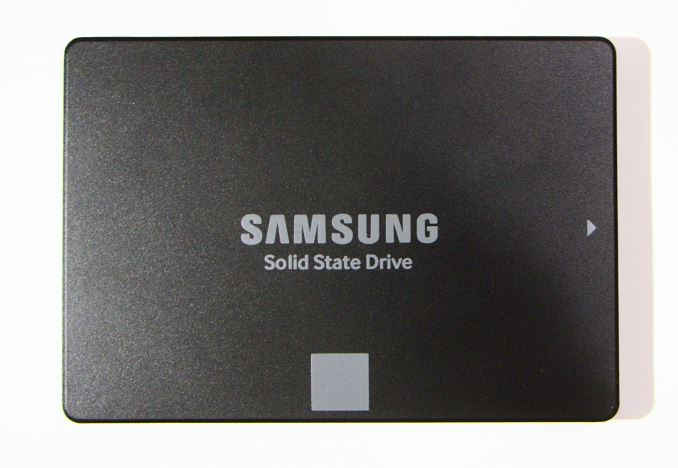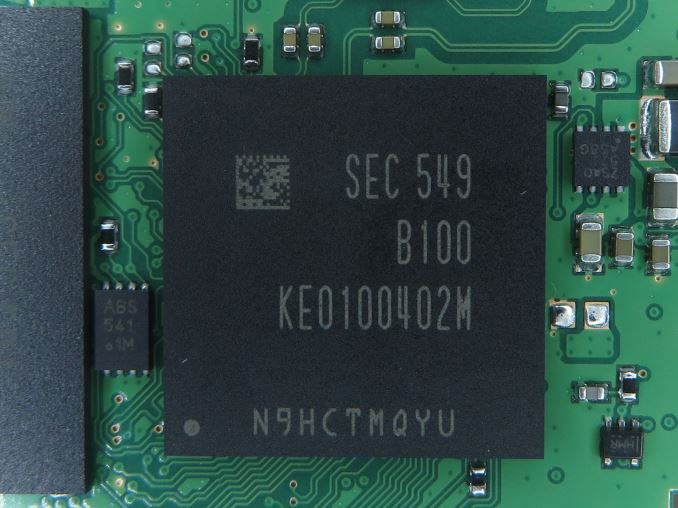The Samsung 750 EVO (120GB & 250GB) SSD Review: A Return To Planar NAND
by Billy Tallis on April 22, 2016 8:00 AM EST
Since the introduction of their first consumer TLC SSD with the SSD 840, Samsung's consumer/retail SATA SSD lineup has consisted of two product families: the MLC-based Pro drives, and the TLC-based 840 and EVO drives. The strength of Samsung's SSD controllers and the advantages of 3D NAND have allowed the 850 EVO to maintain a solidly mid-range position in the SSD market well above any other drive using TLC NAND.
Meanwhile, with the strength of the 850 EVO as a near-midrange product - and with pricing to match - like so many other vendors over the last year, Samsung has also been developing a true low cost TLC drive for the mass market. The end result is the Samsung 750 EVO, which we're revieiwng today. The 750 EVO establishes a new budget-oriented product line that competes in the cutthroat low end of the market where price per GB is the most important aspect of the product.
There are several design choices that help minimize the cost of the 750 EVO, aside from the obvious choice of TLC over MLC. The MGX controller it borrows from the lower capacity 850 EVOs is a dual-core version of Samsung's usual triple-core architecture. Similarly, the 750 EVO is only available in 120GB and 250GB sizes, so there is no high-priced high capacity model. Consequently, with only two small capacities, the 750 EVO line is served by a single tiny PCB layout, made even smaller by the fact that Samsung has put the 256MB of DRAM in the same package as the SSD controller.

Samsung MGX controller with onboard 256MB DRAM
But the most significant aspect of the 750 EVO is that it doesn't use the 3D NAND that has been a key competitive advantage for Samsung's 850 product lines. Samsung has continued development of planar NAND even after transitioning their retail SSDs to 3D NAND, and the 750 EVO in turn uses 16nm planar TLC. It doesn't offer the same performance or endurance of Samsung's 3D NAND, but it does significantly lower the cost of the drive.

128GB of 16nm TLC NAND in a single package
The 16nm TLC NAND is the successor to Samsung's 19nm TLC that had a troubled tenure in the 840 EVO. With the 840 EVO, data at rest on the drive degraded over time and eventually required the use of more thorough and thus slower error correction when read back. As a result the 750 EVO inherits the benefits of all the firmware work Samsung did to mitigate the read speed degradation. This, for what it's worth, gives Samsung some degree of a leg-up against other 16/15nm TLC drives that face the same challenges.
| Samsung TLC SATA SSD Comparison | |||||
| Drive | 750 EVO 120GB | 750 EVO 250GB | 850 EVO 120GB | 850 EVO 250GB | |
| Controller | MGX | MGX | |||
| NAND | Samsung 128Gb 16nm TLC | Samsung 32-layer 128Gbit TLC V-NAND | |||
| DRAM | 256MB | 256MB | 256MB | 512MB | |
| Sequential Read | 540MB/s | 540MB/s | 540MB/s | 540MB/s | |
| Sequential Write | 520MB/s | 520MB/s | 520MB/s | 520MB/s | |
| 4KB Random Read | 94K IOPS | 97K IOPS | 94K IOPS | 97K IOPS | |
| 4KB Random Write | 88K IOPS | 88K IOPS | 88K IOPS | 88K IOPS | |
| 4KB Random Read QD1 | 10K IOPS | 10K IOPS | 10K IOPS | 10K IOPS | |
| 4KB Random Write QD1 | 35K IOPS | 35K IOPS | 40K IOPS | 40K IOPS | |
| DevSleep Power | 6mW | 2mW | |||
| Slumber Power | 50mW | 50mW | |||
| Active Power (Read/Write) | 2.1W / 2.4W (Average) | 2.4W / 2.8W (Average) | Max 3.7W / 4.4W | ||
| Encryption | AES-256, TCG Opal 2.0, IEEE-1667 (eDrive) | AES-256, TCG Opal 2.0, IEEE-1667 (eDrive) | |||
| Endurance | 35TB | 70TB | 75TB | ||
| Warranty | Three years | Five years | |||
By and large the performance specifications for the 750 EVO match the lower capacity 850 EVO, though a slightly lower random write speed at a queue depth of one hints that the 750 EVO may require a bit more background wear leveling work. The feature set is identical to the 850 EVO, making the 750 EVO one of the few low-end drives to support TCG Opal encryption.
Samsung's marketing strategy for the 750 EVO is a little different from their previous retail SSD products. The 750 EVO is targeted specifically at system integrators and system builders, rather than at users looking to upgrade an existing machine. Consequently, they aren't pushing to make the 750 EVO available from as wide a range of retail outlets. Enough of the major online retailers have it in stock that it is not difficult to obtain.
This review will focus on comparing the 750 EVO against Samsung's other SATA SSDs and against other current-generation low-end TLC SSDs of comparable capacity. Our Bench tool can assist in making other comparisons.
| AnandTech 2015 SSD Test System | |
| CPU | Intel Core i7-4770K running at 3.5GHz (Turbo & EIST enabled, C-states disabled) |
| Motherboard | ASUS Z97 Pro (BIOS 2701) |
| Chipset | Intel Z97 |
| Memory | Corsair Vengeance DDR3-1866 2x8GB (9-10-9-27 2T) |
| Graphics | Intel HD Graphics 4600 |
| Desktop Resolution | 1920 x 1200 |
| OS | Windows 8.1 x64 |
- Thanks to Intel for the Core i7-4770K CPU
- Thanks to ASUS for the Z97 Deluxe motherboard
- Thanks to Corsair for the Vengeance 16GB DDR3-1866 DRAM kit, RM750 power supply, Carbide 200R case, and Hydro H60 CPU cooler










109 Comments
View All Comments
Coup27 - Friday, April 22, 2016 - link
SATA is not yesterdays tech.abrowne1993 - Friday, April 22, 2016 - link
More like yesteryearDeath666Angel - Friday, April 22, 2016 - link
So, everyone with perfectly capable CPUs that are barely slower than current tech should upgrade because SATA is old? I'm not disputing that SATA is the older tech, I'm just looking for a more nuanced and realistic view here. If your workload is sufficiently dependant on IO throughput, by all means get those NVMe drives. But implying that a SATA3 device like a 850pro is not going to do the job for a lot of people.... I have a Z87 4770k running at 4.5GHz. I'm not going to upgrade just for the convenience of M.2 PCIe NVMe support. And I won't do so until 6+ core CPUs with comparable IPC and OC abilities get decently priced.Meteor2 - Saturday, April 23, 2016 - link
No, not at all, and no-one said SATA is inadequate. But it is part of the past, just like 486s and dial-up modems.Bleakwise - Sunday, April 24, 2016 - link
No, SATA has a place. You realize a 2.5 SATA drive has about 10x-20x the volume of a NVME drive. No reason you could n't have a 3.5 inch SATA SSD either.Thus SATA will always be the go-to for high volume storage. Flash memory isn't going to be shrunk down anytime soon either, it degrades both performance and reliability, so until we get something better than flash SATA is going to be the only place you can get something like a 4TB or 8TB SSD.
Bleakwise - Sunday, April 24, 2016 - link
Shinking thing smaller and smaller is also more expensive, and like I said in terms of flash it also degrades performance. It's much cheaper to build a big-fast thing than a small-fast thing.There is also the issue of RAID and mechanical drives for mass storage. I can setup a 20TB fakeraid with an SSD write-back cache for under a thousand dollars. Hardware raid would be about 2000$. The NVME version would be about 8000$ to 10000$.
Billy Tallis - Sunday, April 24, 2016 - link
There are 2.5" NVMe drives using the U.2 connector to provide the same 4 lanes of PCIe that can be supplied by the M.2 connector.slowdemon21 - Friday, April 29, 2016 - link
Agree. SATA is the skylake bottleneckewitte - Tuesday, May 24, 2016 - link
I hacked my bios to run a 950 pro in a z87 it was ridiculous to spend so much upgrading from a 4790k.Coup27 - Friday, April 22, 2016 - link
Do you not think there is something wrong with the phrase "consumer grade NVMe 2TB+ SSD" ?You could also RAID some SATA 2TB SSD's to give you want you need. I doubt you "really" need all of that space on NVMe, so maybe a 256 or 512GB 950 Pro + some 850 EVO's in RAID would work well, and is available now.